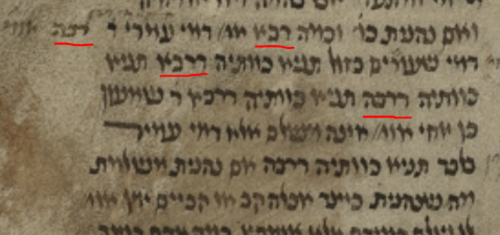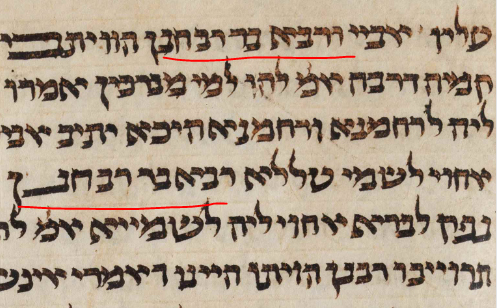
On Bava Kamma 20a, Rabba and Rava argue about the level of compensation one must pay if an animal ate expensive produce in the public square. The preceding Mishnah had specified that the cow’s owner need not pay the full price. Rather, מְשַׁלֶּמֶת מַה שֶּׁנֶּהֱנֵית, he pays for the benefit it derives. Rabba (b. Nachmani) explains that this is דְּמֵי עָמִיר, the value of stalks of hay or straw. Rava (b. Yosef b. Chama) explains that this is דְּמֵי שְׂעוֹרִים בְּזוֹל, the value of barley, based on the cheapest price on the market.
I don’t raise livestock, but one doesn’t feed cattle only hay or only barley. Barley is an energy-rich grain, while hay provides roughage. Depending on the purpose, such as breeding, or producing beef or milk, you might have a different mix to meet different nutritional targets. Rabba’s benefit is cheaper, and for some cows, perhaps the energy needs have already been met so all that’s needed is roughage or food volume. Rava’s benefit is dearer, for the costly food does provide energy and nutrients.
Rabba appears first in the Gemara, because he’s a third-generation Amora, while Rava is a second-generation Amora. Amoraim typically appear in chronological order. The Vatican 116 manuscript reverses their identities, both in the initial statements and in the ensuing discussion, I’d guess influenced by halachic decisive concerns—we rule X, so A and not B must be the one who expresses idea X. (It also accidentally omitted the first Rabba and had to add him in the margins.) On the other hand, Munich 95 also initially had this Rabba/Rava reversal, then fixed the text to place them in chronological order.
Who Should Win?
The Rif (ad loc.) notes that some rule like Rabba, since he is Rava’s teacher. (We see this play out, for instance, in Rabbi Yochanan arguing with his student Reish Lakish. An appropriate melitza would be Kiddushin 42a, דִּבְרֵי הָרַב וְדִבְרֵי תַּלְמִיד – דִּבְרֵי מִי שׁוֹמְעִים? There it is listening to God vs. listening to a human being who sends you in agency to perform a sinful action.) The Rif continues that some rule like Rava, since he is a later authority (batra).
The Rosh (2:5) quotes the Rif. He also quotes the Ra’avad, that Rava’s support brayta reflects the majority, so we rule like him. That is, there’s a brayta supporting both Rabba and Rava. The one supporting Rabba quotes an individual Tanna, Rabbi Shimon ben Yochai, and uses Rava’s exact language. The one supporting Rava is anonymous, and we can assume it then reflects the majority position. It describes it as דָּבָר הָרָאוּי לָהּ, אַף עַל פִּי שֶׁאֵינוֹ רָגִיל, which might be understood to match Rava’s more expensive barley. It is an interesting approach to look at the majority and minority within earlier sources, rather than later generations, to determine how to rule. I’d have assumed that Rabba and Rava were aware of these precedents, and selected their positions despite any minority position.
Rosh elsewhere discusses the Rabba/Rava relationship. For instance, Rosh on Bava Kamma 2:1, regarding זרק כלי מראש הגג ובא אחר ושברו Rabba is certain and Rava isn’t, and Rosh notes that Rava is Rabba’s student. Rosh on Eruvin 2:4 mentions the teacher / student relationship, so that Rabba wins, because hilcheta kebatrai only takes effect from (fourth-generation) Abaye and Rava’s generation and on. Contrast this with Rosh on Bava Metzia 4:19, where he first emends a Rava / Abaye dispute to a Rabba/Abaye dispute, then rules like the student Abaye since he’s the later authority.

Rava’s Teacher?
Much hinges on the teacher-student relationship. I don’t think that if it were third-generation Rav Sheshet against fourth-generation Abaye, we’d assert that Rav Sheshet is Abaye’s teacher. It isn’t the relative scholastic generation; it’s actually functioning as a teacher that matters. Thus, the question arises. Was Rabba indeed Rava’s teacher, in the same way Rav Yosef was Rava’s teacher?
Rava was born in Mechoza. He learned with his father, but his primary teacher was Rav Nachman (bar Yaakov). He also learned from Rav Yosef and Rav Chisda. However, we don’t find him regularly citing Rabba bar Nachmani. Yes, Rabba led Pumbedita academy, then Abaye, and then Rava, but what establishes him specifically as Rabba’s student? For instance, I don’t think we find Rava citing Rabba, in the same way Abaye does.
One strong possibility is Berachot 48a. The preceding context is Rav Nachman’s statement that a minor who knows to Whom one recites a blessing is included in a zimmun. Abaye and Rava were sitting before Rabba, who asked them “to whom do we bless?” They responded “to the All-Merciful.” “And where does the All-Merciful reside?” Rava pointed to the ceiling. Abaye went outside and pointed to the sky. Rabba said “You will both become Sages.” This is as the popular saying goes, a cucumber can be recognized from its blossoming stage.
That tale sets a young Rava against a young Abaye, making them approximately the same age, and also places them in Rabba’s house. And it is the perfect tale, since Abaye and Rava are always arguing in halacha throughout the Talmud. They would display the same inclination to take contrary positions in their youth.
Now, Abaye’s presence makes sense, as he was orphaned and adopted by his uncle Rabba. But, Rava grew up in Mechoza, Rav Nachman was in Mechoza. What would Rava be doing in Pumbedita at such a young age? (And, Abaye stayed in Pumbedita This bothers Rav Aharon Hyman, in Toledot Tannaim vaAmoraim, and he therefore adopts the Behag’s girsa, that the story is about Abaye and Rava bar Rav Chanan. This was a fourth-generation Amora based in Pumbedita. Indeed, several texts have Rava bar Rav Chanan, including the Faro printing and, among manuscripts, Florence 7, Munich 95, Rab. 26, Cambridge 106 and 113. Others such as Oxford 366 and Paris 671 have plain Rava.
Despite how wonderful it would be to have young Abaye fighting with young Rava, I’d have to favor the reading of Rava bar Rav Chanan. It is well-attested in manuscripts, and it makes secret sense in a way not immediately apparent to scribes. Meanwhile, it is easier to omit a בר רב חנן and change to the famous Amora Rava than it is to add a spurious בר רב חנן and move to an obscure Amora. “Lectio difficilior potior” applies, the more difficult reading is stronger and original. If so, this isn’t evidence of Rabba as Rava’s teacher, nor am I aware of other evidence. The principle of ruling like the teacher over his student should then not be applied.
Rabbi Dr. Joshua Waxman teaches computer science at Stern College for Women, and his research includes programmatically finding scholars and scholastic relationships in the Babylonian Talmud.









